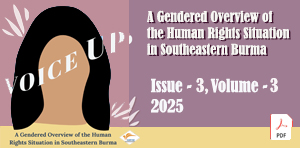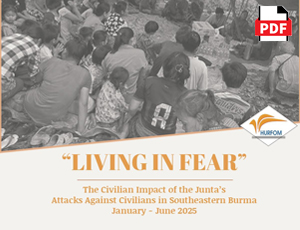A home for the unwanted
March 12, 2010
WCRP: “I want to go back home. Can you take me?” a mentally challenged woman asked me while my friend and I were visiting the Safe House near Huay Malai in Kanchnaburi province, Thailand. But for this woman, and many of her fellow patients, the Safe House serves as the only “home” such individuals can find.
 It had taken us about 45 minutes to travel to the Safe House by motorbike. When we arrived the manager, Daw Paw Lu Lu, was accompanying an HIV positive patient to the Kwai River Christian Hospital, a five minutes drive from the Safe House. As we waited to interview her, staff from the Safe House gave us a tour of the organization’s grounds and projects. Small houses and buildings connected by gardening projects, fish banks and a pig farm scattered the Safe House property. When Daw Paw Lu Lu returned we sat down and she patiently answered my questions about the Safe House, while my friend photographed the weaving centre.
It had taken us about 45 minutes to travel to the Safe House by motorbike. When we arrived the manager, Daw Paw Lu Lu, was accompanying an HIV positive patient to the Kwai River Christian Hospital, a five minutes drive from the Safe House. As we waited to interview her, staff from the Safe House gave us a tour of the organization’s grounds and projects. Small houses and buildings connected by gardening projects, fish banks and a pig farm scattered the Safe House property. When Daw Paw Lu Lu returned we sat down and she patiently answered my questions about the Safe House, while my friend photographed the weaving centre.
Daw Paw Lu Lu, a 61-year-old Karen woman, the Thailand Burma Border Consortium (TBBC), and the Christian Church of Thailand, founded the Safe House in 1993. The Safe House was a coordinated effort of the three organizations to aid the increasing number of displaced migrants struggling to survive on and around the Thailand-Burma border. Over the past 17 years, the Safe House has treated over 1500 patients suffering from varying illnesses. Patients of the Safe House are members of various nationalities, ethnicities and religions; presently there are Mon, Shan, Karen, Arakan, Akha, Thai, Malay, Khmer and Indian patients at the residence.
 Daw Paw Lu Lu explained to me that the aim of the Safe House is to help mentally impaired, or terminally ill, individuals who have no other option. This includes individuals suffering from: HIV/AIDS, Post-traumatic Stress Disorder, Tuberculosis (TB), schizophrenia, mania, epilepsy, intellectual disabilities, and various other ailments.
Daw Paw Lu Lu explained to me that the aim of the Safe House is to help mentally impaired, or terminally ill, individuals who have no other option. This includes individuals suffering from: HIV/AIDS, Post-traumatic Stress Disorder, Tuberculosis (TB), schizophrenia, mania, epilepsy, intellectual disabilities, and various other ailments.
In the past, most of the HIV/AIDS patients that came to the clinic were men but now the clinic is admitting more women. Daw Paw Lu Lu thinks the increase is due to the rise in women migrating to and working in Thailand.
Since she was 27, Daw Paw Lu Lu has been studying and providing healthcare on and around the Thailand-Burma border. Initially running the Safe House alone, she now has a round-the-clock staff of 14. Other then caring for patients, Safe House staff runs various recreational, rehabilitation and vocational programs to aid in the patients’ recovery. Able patients can tend to the: vegetable gardens, fish banks or pig farm. Other activities include: soccer, crafts, brick making and chicken husbandry. Additionally, the Safe House’s weaving centre and loom project teaches patients how to weave Karen bags, purses, scarves and various other goods.
Ma Htin Phyu, a 22-year-old Karen women, who runs the loom project explained to me how she came to the Safe House:
One day a troop of SPDC soldiers were fighting in my village so we ran to Nu Poe refugee camp. While I was living in the camp, my aunt contacted me and invited me to live with her in Huay Malai and she told me about the Safe House. So my husband and I came, and we now live with my aunt. When I arrived, I attended the loom training and now I work at the Safe House. I don’t want to go back to my village because if I live in my village I will constantly worry about SPDC soldiers. I am very happy to work here. I also have two children who attend the Christian school in Huay Malai.” Ma Htin Phyu is from Paw Nan village, Karen State, and has worked at the Safe House for several years.
 Through the weaving centre and loom project, the Safe House provides jobs and opportunities for patients to earn an income if and when they are capable. At the front of the Safe House there is a small store where all the goods from the two projects are sold. When an item is purchased the profit goes back to the maker.
Through the weaving centre and loom project, the Safe House provides jobs and opportunities for patients to earn an income if and when they are capable. At the front of the Safe House there is a small store where all the goods from the two projects are sold. When an item is purchased the profit goes back to the maker.
In a separate building, there are 30 live-in children; some sick, some orphaned, and some merely the children of patients. TBBC provides funds so the children are able to attend the local Christian school.
“I have been working here [the Safe House] for five years. My duty is to care for the children, I teach them on the weekends, prepare food, and make sure they are healthy… Also I teach them Burmese, English, Karen, and do Math with them. I am tired, but I am happy to take care of them. They are very cute,” said Ma Joe Phyu, a 49-years-old Karen woman from Kyain Seikgyi Township, Karen State, who is responsible for the live in children. In total, three Safe House staff members tend to the children while they are not attending school. In an attempt to accommodate all students, the Christian school, provides language classes in Karen, Burmese, English, Thai, and Mon.
Currently the Safe House is supporting 42 patients, 19 female and 23 male with the average age of 37. There are six adults and two children with HIV/AIDS, 22 patients are mentally ill, 14 patients are suffering from an assortment of chronic physical illnesses. Additionally there are 10 chronically sick elderly patients over the age of 70. TBBC provides the: staff, rent, food, clothes, furniture, appliances, cutlery, medicine, and medical supplies for occupants of the Safe House. The Safe House is currently in the midst of a 5-year plan to become independent.
Potential patients have to meet strict criteria before the Safe House is able to accept them as in-patients. Admitted patients usually do not have a home, family or any kind of support network. Patients that cannot or do not recover, are able to rely on or live at the Safe House for extended periods of time.
Land limitations are currently creating difficulties for the Safe House and its occupants. The 22 mentally ill patients share two cramped dorm like spaces, which are divided by sex. Daw Paw Lu Lu explained that due to the confined quarters, fights are quite common.
“We do not have enough land and it causes problems. Also, the land that we use is rented and the landlord may want it back in the future. We also do not have enough toilets.” Said Daw Paw Lu Lu. For the 42 occupants and 14 staff there are only four toilets, two of which are inside the mentally impaired patients’ male quarters. When fights break out, between the patients, or if the quarters are locked, everyone is blocked from using the toilets.
“I want to help the people who have no place to stay and no one to care for them. I try to give them a place to sleep and treat their diseases. I also try to help migrant workers who have problems and make it so they can stay in our Safe House comfortably.” Said Daw Paw Lu Lu.
By Chan Chan
Comments
Got something to say?
You must be logged in to post a comment.



















































